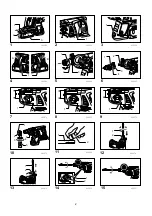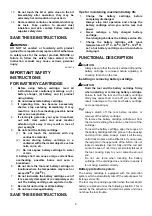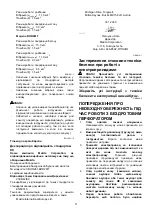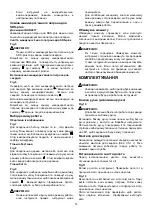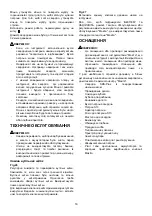
7
•
When the tool is overloaded:
At this time, release the switch trigger and
remove causes of overload and then pull the
switch trigger again to restart. When the tool
does not work even after pulling the switch
trigger, the battery power auto-stop is still at
work. Charge the battery cartridge before
use.
•
When the remaining battery capacity becomes low:
Recharge the battery cartridge.
Switch action
Fig.2
CAUTION:
•
Before inserting the battery cartridge into the tool,
always check to see that the switch trigger actuates
properly and returns to the "OFF" position when
released.
To start the tool, simply pull the switch trigger. Tool speed
is increased by increasing pressure on the switch trigger.
Release the switch trigger to stop.
Lighting up the lamp
Fig.3
CAUTION:
•
Do not look in the light or see the source of light
directly.
Pull the switch trigger to light up the lamp. The lamp
keeps on lighting while the switch trigger is being pulled.
The light automatically goes out 10 - 15 seconds after the
switch trigger is released.
NOTE:
•
Use a dry cloth to wipe the dirt off the lens of lamp.
Be careful not to scratch the lens of lamp, or it may
lower the illumination.
•
Do not use thinner or gasoline to clean the lamp.
Such solvents may damage it.
Reversing switch action
Fig.4
This tool has a reversing switch to change the direction of
rotation. Depress the reversing switch lever from the A
side for clockwise rotation or from the B side for
counterclockwise rotation.
When the reversing switch lever is in the neutral position,
the switch trigger cannot be pulled.
CAUTION:
•
Always check the direction of rotation before
operation.
•
Use the reversing switch only after the tool comes
to a complete stop. Changing the direction of
rotation before the tool stops may damage the tool.
•
When not operating the tool, always set the
reversing switch lever to the neutral position.
Changing the quick change chuck for
SDS-plus
For model BHR261T
The quick change chuck for SDS-plus can be easily
exchanged for the quick change drill chuck.
Removing the quick change chuck for SDS-plus
Fig.5
CAUTION:
•
Before removing the quick change chuck for
SDS-plus, always remove the bit.
Grasp the change cover of the quick change chuck for
SDS-plus and turn in the direction of the arrow until the
change cover line moves from the symbol to the
symbol. Pull forcefully in the direction of the arrow.
Attaching the quick change drill chuck
Fig.6
Check the line of the quick change drill chuck shows the
symbol. Grasp the change cover of the quick change
drill chuck and set the line to the symbol.
Place the quick change drill chuck on the spindle of the
tool.
Grasp the change cover of the quick change drill chuck
and turn the change cover line to the symbol until a
click can clearly be heard.
Selecting the action mode
Rotation with hammering
Fig.7
For drilling in concrete, masonry, etc., depress the lock
button and rotate the action mode changing knob to the
symbol. Use a tungsten-carbide tipped bit.
Rotation only
Fig.8
For drilling in wood, metal or plastic materials, depress
the lock button and rotate the action mode changing
knob to the
symbol. Use a twist drill bit or wood bit.
Hammering only
Fig.9
For chipping, scaling or demolition operations, depress
the lock button and rotate the action mode changing
knob to the
symbol. Use a bull point, cold chisel,
scaling chisel, etc.
CAUTION:
•
Do not rotate the action mode changing knob when
the tool is running. The tool will be damaged.
•
To avoid rapid wear on the mode change
mechanism, be sure that the action mode changing
knob is always positively located in one of the three
action mode positions.
Torque limiter
The torque limiter will actuate when a certain torque level
is reached. The motor will disengage from the output
shaft. When this happens, the bit will stop turning.


